 Image search results - "aga" Image search results - "aga" |
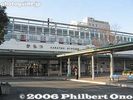
JR Karatsu Station
|
|
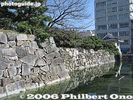
Higo Moat and turret (?)This is near the Karatsu City Hall. From Karatsu Station, it takes about 25 min. to walk to the castle tower.
肥後堀
|
|

Kanagawa Prefecture's largest Awa Odori is held annually during the last weekend in July in this city of Yamato. Preview event near Yamato Station.
|
|

Hanegi Park is near Odakyu Umegaoka Station ("Umegaoka" means plum hill). 小田急梅ヶ丘駅
|
|

Kanayama Jinja Shrine is a small shrine within the grounds of the Wakamiya Hachimangu Shrine near Kawasaki Daishi Station. On the first Sun. of April, it holds this now-famous Kanamara Festival nicknamed the Phallus or Fertility Festival. Festival starts at 11 am. But a large crowd was already there well before that time. Entrance to shrine on the day of the Kanamara Festival. (If you're below age 18, please leave now.)
|
|

JR Nagano Station festooned with Olympic logos.
|
|

PR poster designed by Tetsuo OshiroPoster for the race.
京都大学ボート部OBの尾城徹雄様に作成したポスター。大学内や大津市石山商店街などで張り出された。
|
|
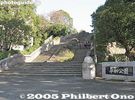
Entrance to the Peace Park
|
|

From late April to early May, five long strings of giant carp streamers swim in the air high above the Sagami River in Sagamihara, Kanagawa. This event was started in 1988.
|
|
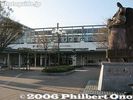
JR Karatsu Station
|
|
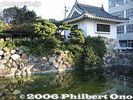
Turret (?)
|
|

The Azuchi Nobunaga Festival's main venue was here, next to Azuchi Castle (hill on right). MAP
|
|
|
|

Entrance to Hanegi Park's plum grove
|
|

Shrine banners and cherries in full bloomThe red banner says "Kanayama Jinja" with an phallus (erect) logo on the top.
|
|

Welcome sign at Nagano Station
|
|

Peace Fountain with the Peace Statue in the distanceA fountain of water was made for the victims who were desperate for water.
|
|

There are five rows of streamers. In Japan, the koi carp is regarded as a symbol of valiant manhood because it swims up the river against the rapids.
|
|
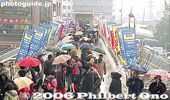
Nagano Station, East Exit to Olympic PlazaAt the East Exit of Nagano Station, this bridge, lined with advertising banners, led the way to the Olympic Plaza which featured ten tent pavilions made by official sponsors.
|
|

Kunchi monument at Karatsu StationKaratsu's most famous festival is the Hikiyama Kunchi Festival where large floats are paraded around.
|
|

The turret turned out to be a public toilet...Looked nice enough to photograph, but when I walked around it, it smelled like the toilet it was.
|
|
|
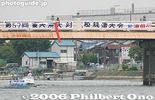
Karahashi Bridge as the starting point for alumni races
|
|

Pre-festival event held in the afternoon, Yamato Awa Odori
|
|

The plum trees are on a small hill.
|
|

Pumping (or humping) the...
|
|
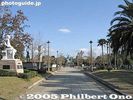
Path to Peace Statue
|
|

The cable length is 250 meters and 13mmm thick. There are about 1,200 carp streamers. They are reused every year and donated by local families. (I also noticed a few advertising carps.)
|
|
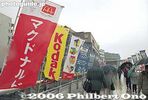
To Olympic Plaza
|
|

Higo Moat
|
|
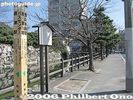
Sightseeing marker in English
|
|

Stage entertainment (Azuchi Castle ruins in background).
|
|
|
|

Hanegi Park has plum blossoms in mid-Feb. to early Mar. It has about 700 plum trees and also sports facilities and public library.
|
|

The festival is wildly popular with people from overseas.The shrine had various phallus props to pose with.
|
|
|
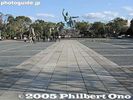
Peace StatueEvery Aug. 9, the anniversary of the atomic bombing, a memorial service is held here.
|
|

Pavilion by Kirin Brewery.Notice the "wrap" bus passing in front.
|
|
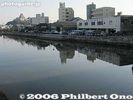
River and castle in the distance
|
|

Hikiyama Float Exhibition Hall曳山展示場
|
|

Demonstration of matchlock guns, Azuchi Nobunaga Festival in Azuchi, Omi-Hachiman.
|
|

Kyoto Univ. in dark blue T-shirts
|
|

Yamato Station
|
|
|

Dickhead hat. Actually, I don't know what they call it, but that's what I call it.
|
|
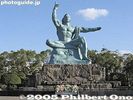
Peace StatueSculptor was Seibo Kitamura.
|
|
|

Olympic PlazaSnowlets House and Kodak's pavilion behind it.
|
|

Bridge to castle城内橋
|
|
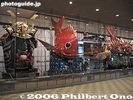
Inside Hikiyama Float Exhibition HallKunchi festival floats are displayed.
曳山展示場
|
|

They came from Hikone. 鉄砲隊演武(彦根鉄砲隊)
|
|
|

Balloons, souvenirs and trinkets sold near the train station.
|
|
|

Carving daikon. Anybody can join in and carve. 大根削りLater to be auctioned off.
|
|

The Peace Statue was built in Aug. 1955, the 10th anniversary of the bombing. The Peace Statue was modeled after popular wrestler Rikidozan.
|
|

Sagami River Koi-nobori
|
|
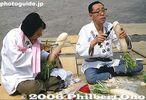
Carving daikon (old photo). These men were really good at carving the daikon.
|
|
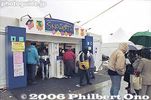
Entrance to Snowlets House at Olympic Plaza.The official store for Olympic souvenirs. There were a lot of ticket scalpers (all foreigners) hanging around the entrance. Inside, there was a ticket counter for events which still had seats.
|
|
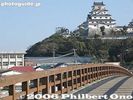
Jonai Bridge to castle城内橋
|
|
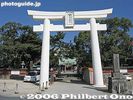
Karatsu Shrine
|
|
|

Finish line 300 meters later
|
|
|
|
|

The folded right leg symbolizes quiet meditation.
|
|
|
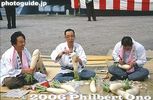
Carving daikon. Since some activities are conducted on the ground, the festival is also called Jibeta (Ground) Matsuri.Once upon a time, the festival was still mostly a local event with much fewer people.
|
|

Snowlets HouseIt was packed. This is part of the checkout line. There were four checkout lines and each one was about 30 meters long. The line went pretty fast though. They had all kinds of souvenirs: T-shirts, sweatshirts, flags, postcards, pins, key chains, necklaces, stuffed Snowlets, mugs, and even jewelry. I went on the 6th day of the Games and it still had everything well in stock. But I later heard that the shelves were laid bare well before the Games ended.
|
|
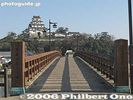
Jonai Bridge to castle城内橋
|
|
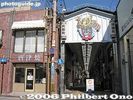
Gofuku-cho shopping arcade
|
|

Demonstration of matchlock guns, Azuchi Nobunaga Festival.Even these people had to obtain police permission to bear and fire these feudal-era guns.
|
|

Tokyo Univ. (Todai) crew return to land after a race
|
|

Main drag and shopping arcade called Yamato Chuo-dori大和中央通り
|
|
|

The right hand points to the threat of nuclear weapons.The bronze statue is 10 meters tall.
|
|
|
|
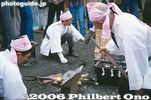
Forging a steel phallus (old photo)The demon living in the vagina of the women bit the man's phallus each time. So one guy made a steel phallus and the demom broke his teeth.
|
|
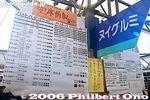
Snowlets House, ticket availability
|
|
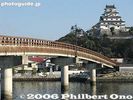
Jonai Bridge to Karatsu Castle城内橋
|
|

Gofuku-cho shopping arcade
|
|

Boat ride along the moat of Azuchi Castle.
|
|
|

Spectators wait for the parade to begin.
|
|
|
|

The closed eyes express a prayer for all war victims.
|
|
|

JR Okaya Station. There is no tourist info office here.Small station, but close to Lake Suwa.
|
|

Numerous azalea bushes
|
|

JR Kami-Suwa Station
|
|

Castle tower
|
|

Lake SuwaYou can rent a bicycle at Kami-Suwa Station and ride along the lake shore.
|
|
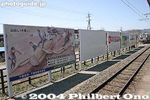
Billboard depicting Ki-otoshi (Log Drop) at Shimosuwa Station.
|
|
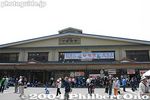
Shimosuwa Station on May 8, 2004. Here for the final three days of the Onbashira Matsuri's climax, the Satobiki when they haul the Onbashira logs to the Shimo-sha Shrines (Akimiya and Harumiya) and erect them.
|
|
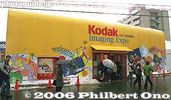
Kodak's Kodak-yellow pavilionOn the day I went in, they introduced Jamaica's bobsled team. They are very popular in Japan, largely due to the comedy movie "Cool Running" which was aired in Japan before the Nagano Games started.
|
|

Nagahama Hachimangu Shrine torii on New Year's Day. Nagahama's most popular shrine for New Year's worship (hatsumode). MAP
|
|

Lord Ishida Mitsunari was born in 1560 in Ishida village in Nagahama, Shiga Pref. You can see the site of his birthplace by bus from Nagahama Station. Get off at the Ishida bus stop. MAPHis birthplace and former residence have monuments dedicated to this fallen but revered leader of the Western Forces which lost to Tokugawa Ieyasu at the Battle of Sekigahara in 1600. He was a protégé and main samurai retainer of Toyotomi Hideyoshi.
|
|
|
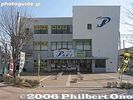
Furusato Kaikan, next to the station
|
|

和船
|
|

Sugawara house from Tsuruoka city, Yamagata Prefecture. In heavy snow, the front window was used as the door.
|
|

JR Okaya Station platform. JR岡谷駅
|
|

June 9, 2007. Hula dancers rush to Pukari Sanbashi Pier where the Hokule'a canoe is to dock. ぷかりさん橋
|
|

The festival/parade starts before dark.
|
|

On July 29, 2007, this regatta was held for the second time. It targets mainly beginner rowers. Organized by the Seta Rowing Club which seeks to have more people enjoy water sports on Lake Biwa. Seta-Karahashi Bridge was the regatta's starting line. The Lake Biwa Rowing Song CD was awarded to all the 1st, 2nd, and 3rd place winners in all five categories.
|
|

Picnic area
|
|

Held during Aug. 3-5 at Taga Taisha Shrine, the Mantosai or 10,000-Lantern Festival is a night festival when numerous lanterns are lit within the shrine grounds. The lanterns are for the repose of ancestral spirits.
|
|

Anegawa River was the site of a major battle with Oda Nobunaga and Tokugawa Ieyasu defeating Azai Nagamasa and the Asakura clan on Aug. 9 1570. The area was left with so many dead that the river ran red.Local place names such as Chibara (Blood Field) stuck. Looking toward Nomura-bashi Bridge where the Anegawa battle monument stands.
|
|

Standing room only at Wakamiya Shrine
|
|

Canora Hall, venue for the Okaya International Exchange Association's 15th anniversary festival.
|
|

Lake Hyoko (Lake Hyo), a man-made lake where thousands of swans and ducks migrate to during the winter months.
|
|

Former Hatano residence and birth home of Yoshida Togo 旧旗野邸 (吉田東伍生家)
|
|

Way to Tagata Shrine from Tagata Jinja-mae Station. Shrine famous for numerous phallic objects used as offerings to the gods. The 1500-year-old shrine worships a deity called Tamahime-no-Mikoto who was a daughter of a powerful local lord from the 5th c.The Honen-sai or Honen (Hounen) Matsuri is held by Tagata Jinja on March 15 to pray for an abundant harvest. "Honen" literally means "Year of abudant harvest." Since a giant penis is used as an offering, it is popularly called the "penis festival."
The shrine is near Tagata Jinja-mae Station on the Meitetsu Railways' Komaki Line. From Shin-Nagoya Station or Shin-Gifu Station, go to Inuyama Station and transfer to the Komaki Line.
|
|

Tagata Jinja-mae Station on Meitetsu Railways' Komaki Line, a few stops from Inuyama Station. The shrine is a 10 min. walk from the train station.
|
|

The outstretched left hand symbolizes tranquility and world peace.
|
|

The longest carp is 10 meters.
|
|

Shimosuwa Station 下諏訪駅
|
|

Onbashira monument in front of Shimosuwa Station. This Onbashira log was used in the opening ceremony of the Nagano Winter Olympics in 1998.
|
|
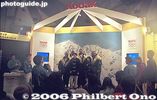
Jamaica's bobsled team in Kodak PavilionThey introduced Jamaica's bobsled team. They are very popular in Japan, largely due to the comedy movie "Cool Running" which was aired in Japan before the Nagano Games started.
|
|

Little stone marker and shrine next to the bus stop.
|
|
|
|
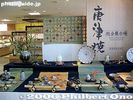
Inside Furusato KaikanKaratsu-yaki pottery is displayed and sold.
|
|

These boat rides are offered only during this annual festival.
|
|

Ceiling
|
|

Univ. of Tokyo alumni crew in light blue T-shirts
|
|

JR Okaya Station platform
|
|

A crowd of a few hundred on hand to greet Hokule'a's arrival.
|
|
|

Sixty rowing teams (300 people) rowed in five categories, including beginner and expert rowers, ranging in age from junior high to senior citizens.
|
|

Stone monument for "Haru no Tsuki" haiku poem by Nakamura Teijo. 「春の月」中村汀女
|
|

Taga Taisha Shrine torii near Taga Taisha-mae Station. MAP
|
|

Nomura-bashi Bridge crosses Anegawa River. This is where Oda Nobunaga battled the Azai clan.
|
|

Packed path to Wakamiya Hachimangu Shrine
|
|

Lobby of Canora Hall
|
|
|

Rear view of birth home of Yoshida Togo who was a famous geographer of Japan who compiled an encylopedia of Japanese place names. His son was Yoshida Chiaki who composed the melody of the song "Biwako Shuko no Uta" (Lake Biwa Rowing Song).
|
|

Festival spectators come by the busload, including people from US military bases such as Yokota.
|
|

Tagata Shrine torii and entrance 田縣神社
|
|
|
|
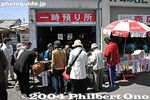
Store your luggage here. Not enough lockers at the train station so they provide this service. 400 yen/day.
|
|
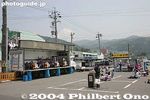
Entertainment stage in front of Shimosuwa Station.
|
|
|

Path to shrine with stone lanterns, and cars.
|
|

Ishida Mitsunari is most famous for the Battle of Sekigahara in 1600 when he unsuccessfully led his Western Forces against Tokugawa Ieyasu's Eastern Forces
|
|

Map of Karatsu
|
|
|

Welcome aboard!
|
|

Kitamura house brought from Hadano, Kanagawa
|
|

View from train station overpass
|
|

Kyoto Univ. alumni crew in dark blue T-shirts
|
|

People crowd the waterfront near Pukari Sanbashi Pier.
|
|
|
|

When I walked around, my planned 20-min. stay turned into a 2-hour walking tour of this pacifying place, full of mountains and a clear river. A delightful discovery. Suigen Park
|
|

This is the boat dock where people got on and off the boats. The boats were provided by local rowing organizations. The regatta was organized by the Seta Rowing Club in Otsu.
|
|

Stone monument for "Haru no Tsuki" haiku poem by Nakamura Teijo. 「春の月」中村汀女
|
|

Road to Taga Taisha Shrine
|
|
|

Prayers to the Kanamara Boat portable shrine かなまら舟神輿 神輿御霊入れ式Before the portable shrine is taken out to be paraded around town, the god of the shrine must be transferred to it. This is what the head priest is doing.
There are three portable shrines (called mikoshi). The Kanamara mikoshi (the original portable shrine), Kanamara-bune mikoshi (shaped like a boat), and Elizabeth mikoshi (pink giant). All three are carried during a procession around town. The Elizabeth mikoshi is carried by she-males. ("New half" in Japanese. Go ahead and laugh if you want.)
|
|

Entrance to the smaller hall
|
|

Duck feeding
|
|

A room in the birth home of Yoshida Togo
|
|

Entering Tagata Shrine, dedicated to Tamahime-no-Mikoto (daughter of a local feudal lord) and Mitoshi-no-Kami (deity of harvests).
|
|

Tagata Shrine stone marker
|
|
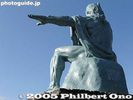
The left leg is poised for action to assist humanity.
|
|

Along the river were food stalls.
|
|
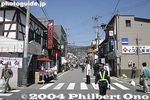
Go straight on this road in front of the station.
|
|
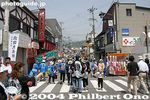
In front of Shimosuwa Station.
|
|

Kita Nagano StationTo get to Aqua Wing, the ice hockey rink, we had to take a local train from Nagano Station for a short ride to the next stop at Kita Nagano Station. This Kita Nagano Station was a tiny little train station certainly not meant for large crowds. It was unbelievably small. It took some minutes before we could get out of the station which was not much larger than a normal living room. The door was also small, enough for only two people to get out at one time.
|
|

Stone lanterns
|
|

Steel sculpture depicting Ishida Mitsunari giving tea to Toyotomi Hideyoshi. Ishida-cho, Nagahama, Shiga Pref.
|
|
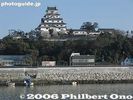
Castle tower and outer wall
|
|

Boat ride
|
|

Kitamura house
|
|

Lala store in front of Okaya Station. A small city hall office inside might be able to give tourist info.
|
|

Kyoto Univ. alumni crew at start line
|
|

People crowd the waterfront near Pukari Sanbashi Pier.
|
|
|

On the side of the road near the bus stop, there is a trail going down to Tama River.
|
|

Completely surrounded by mountains with a clear river running in the middle.
|
|

A rowing team leaves the dock for Seta-Karahashi Bridge seen in the background.
|
|
|

Homes along the way are decorated.
|
|

Battle monument
|
|

Prayers to the Kanamara-bune mikoshi かなまら舟神輿Before the portable shrine is taken out to be paraded around town, the god of the shrine must be transferred to it. This is what the head priest is doing.
|
|

Reception counter with programs and newsletters in different languages.
|
|
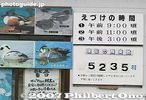
Duck species in the lake and the number of birds so far.
|
|

Garden of the birth home of Yoshida Togo
|
|

Various entertainment is staged within Tagata Shrine up until the procession starts at 2 pm.
|
|

Mikuji paper fortunes for love and romance, marriage, and childbirth.
|
|
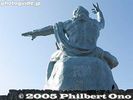
Rear view
|
|

Festival site
|
|
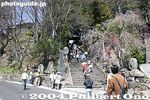
There are no buses nor taxis to where we want to go.
|
|
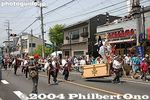
Parade of Nagamochi which are long chests. 長持
|
|
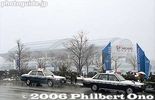
Aqua Wing ice hockey rink
|
|

Every three years (2017, 2020, 2023, 2026, etc.), the full-scale version of this festival is held in mid-Aug. The festival's last day is the climax with this procession of over 50 portable shrines. Led by this banner which reads Tomioka Hachimangu.
|
|
|
|

Steel sculpture depicting Ishida Mitsunari giving tea to Toyotomi Hideyoshi. The road on the left goes to the site of his former residence.
|
|
|
|

Nihon Minkaen is an outdoor museum of traditional farm and merchant houses with thatched roofs. They have 25 homes from around Japan many were donated to the museum for preservation.
|
|

On Karahashi Bridge
|
|

Hokule'a already in sight well before 11 am when it was scheduled to dock.
|
|
|

A suspension bridge over the river.
|
|

A few bridges span the river.
|
|

Seta-Karahashi Bridge, the start line.
|
|
|

Near the shrine entrance are the usual food stalls.
|
|

Anegawa River Battle Memorial
|
|

The shrine's head priest transfers the deity to the Kanamara Boat portable shrine (boat-shaped loaded with a phallus) かなまら舟神輿Before the portable shrine is taken out to be paraded around town, the god of the shrine must be transferred to it. This is what the head priest is doing.
|
|

Exhibition area featuring native costumes, photos, etc.
|
|

In Oct. 2008, Lake Hyoko was added to the list of wetlands of international importance under the Ramsar Convention on Wetlands.
|
|

Entrance to the Yoshida Togo Memorial Museum which exhibits various documents and personal effects of Yoshida Togo. Museum admission 300 yen. Closed Mon.
|
|

Schedule of events and procession route. In odd-numbered years (like 2007), the procession starts from nearby Kumano-sha Shrine. In even-numbered years, the procession starts from Shinmei-sha Shrine.
|
|

Tagata Shrine Honden main hall. Komaki, Aichi Pref.
|
|

Peace Statue description
|
|

Cable anchor
|
|

We had to walk it. This was April 10, 2004, one of the days for Shimo-sha Shrine's Yamadashi when they hauled the logs from the mountain forest.
|
|
|
|
|

Shrine priest on horseback. The start of one of Tokyo's Big Three Festivals. These photos show the festival's climax on the last day of the festival when over 50 portable shrines are paraded along the streets amid splashing water. It is the Rengo
|
|

The shrine grounds was filled with cars on New Year's Day. Apparently, the shrine has no parking lot.
|
|
|
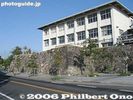
Stone wall and high school next to castle
|
|
|
|

Race starts for Kyoto Univ. alumni
|
|

Hokule'a and escort ship Kama Hele. What makes this canoe so special and famous is that it was used to sail from Hawaii to Tahiti (and many other places) without any modern navigational instruments.
|
|
|

Tama River as seen from the bridge.
|
|
|

Up to four rowing teams raced down a 250-meter straight course.
|
|

Weeping plum blossoms
|
|
|

Anegawa River Battle Memorial, rear view with the battle date engraved.
|
|

A representative of the shrine parishioners offer prayers.
|
|
|

Thousands of ducks
|
|

Inside Yoshida Togo Memorial Museum. The 2nd floor also has a display panel about his son Yoshida Chiaki who composed the song "Hitsuji-gusa" whose melody was used in the song "Biwako Shuko no Uta" (Lake Biwa Rowing Song).
|
|

People line up to rub the sacred balls. Penis rock in the foreground.
|
|

Tagata Shrine Honden main hall which worships shrine worships a deity called Tamahime-no-Mikoto who was a daughter of a powerful local lord from the 5th century.
|
|

Monument next to Peace Statue
|
|
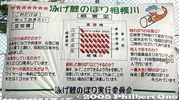
Statistics
|
|
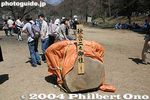
After walking for 30 min., we reached this place called Shimekake, a resting place for the logs which had been hauled from the mountains. This is Log No. 2 for Akinomiya Shrine. 注連掛
|
|
|
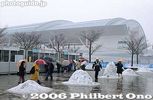
Aqua Wing
|
|

Omiko shrine maidens. On the previous day during the Sacred Carriage Procession, they performed sacred dances on a truck. お巫女
|
|

Another entrance to the shrine
|
|

Monument and bus stop
|
|
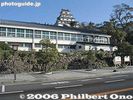
High school and castle tower
|
|

Ahoy there!
|
|
| 10841 files on 44 page(s) |
1 |
 |
 |
 |
 |
|